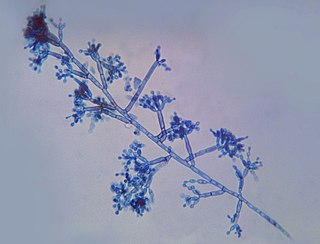
The Chaetothyriales are an order of ascomycetous fungi in the class Eurotiomycetes and within the subclass Chaetothyriomycetidae. The order was circumscribed in 1987 by mycologist Margaret Elizabeth Barr-Bigelow.

The Arthoniales is the second largest order of mainly crustose lichens, but fruticose lichens are present as well. The order contains around 1500 species, while the largest order with lichenized fungi, the Lecanorales, contains more than 14000 species.
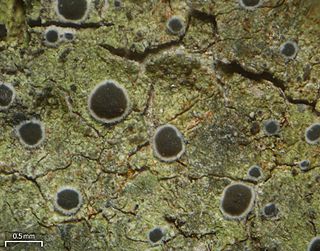
The Pilocarpaceae are a family of crustose lichens in the order Lecanorales. The species of this family have a cosmopolitan distribution and have been found in a variety of climatic regions. Pilocarpaceae was circumscribed by Alexander Zahlbruckner in Adolf Engler's influential 1905 work Die Natürlichen Pflanzenfamilien.

The Graphidaceae are a family of lichen-forming fungi in the order Graphidales. The family contains nearly a hundred genera and more than 2000 species. Although the family has a cosmopolitan distribution, most Graphidaceae species occur in tropical regions, and typically grow on bark.
Trichothelium is a genus of lichen-forming fungi in the family Trichotheliaceae. It has an estimated 40 species. The genus was circumscribed by the Swiss lichenologist Johannes Müller Argoviensis in 1885, with Trichothelium epiphyllum assigned as the type species.

Porina is a genus of lichens in the family Trichotheliaceae. A 2020 estimate places about 145 species in the widespread genus.

Byssoloma is a genus of leaf-dwelling lichens in the family Pilocarpaceae.

Anisomeridium is a genus of lichens in the family Monoblastiaceae. The type species was originally named Arthopyrenia xylogena by Swiss botanist Johannes Müller Argoviensis in 1883; in 1928, Maurice Choisy defined the genus Anisomeridium, designating A. xylogena the type species.

The Trypetheliaceae are a family of mainly lichen-forming fungi in the order Trypetheliales. The family consists almost exclusively of corticolous (bark-dwelling), crustose lichens with an almost strictly tropical distribution.
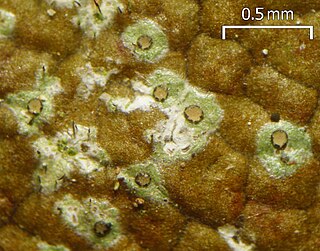
Tricharia is a genus of lichens in the family Gomphillaceae. It has an estimated 30 species.
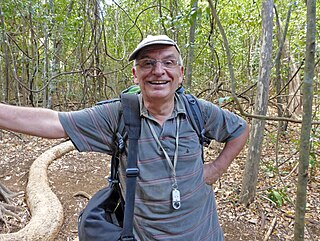
Emmanuël Sérusiaux is a Belgian lichenologist. His career, spanning more than four decades, has combined both lichenology research and political aspects of nature conservation. He spent several periods working as a researcher at the National Fund for Scientific Research and the University of Liège, the latter in which he accepted a faculty position as professor and head of the Plant Taxonomy and Conservation Biology unit. Sérusiaux also served for three non-consecutive appointments as Deputy Chief of Staff in the Government of Wallonia. He retired from both his academic and political positions in 2019.
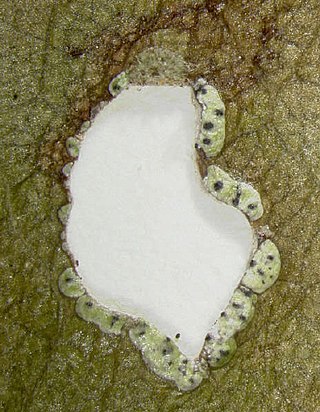
Strigula is a genus of lichen-forming fungi in the family Strigulaceae. The genus was circumscribed in 1823 by English mycologist Elias Magnus Fries.
Serusiauxiella is a genus of leaf-dwelling lichens in the family Strigulaceae. It has three species, all of which are found in wet tropical forests in China. The genus was circumscribed in 2020 by Shu-Hua Jiang, Robert Lücking, and Jiang-Chu Wei, with Serusiauxiella filifera assigned as the type species. The genus name honours Belgian lichenologist Emmanuël Sérusiaux, "in recognition of his important contributions to lichenology, foliicolous lichens and the genus Strigula".

Thelenella is a genus of lichen-forming fungi in the family Thelenellaceae. It has 30 species. The genus was circumscribed by Finnish lichenologist William Nylander in 1855, with Thelenella modesta assigned as the type species.

Strigulales is an order of lichen-forming fungi in the class Dothideomycetes. It contains two families: Strigulaceae and Tenuitholiascaceae, with a combined total of 115 species. The order was proposed by Robert Lücking, Matthew Nelsen, and Kevin Hyde in 2013. Most species in the order are foliicolous, that is, they grow on plant leaves.
Swinscowia is a genus of lichen-forming fungi in the family Strigulaceae. It has 34 species. Swinscowia was proposed in 2020 by lichenologists Shu-Hua Jiang, Robert Lücking, and Emmanuël Sérusiaux to contain non-foliicolous species that were isolated from bark and rocks. Swinscowia jamesii, a species that was originally described in genus Geisleria, and later transferred to Strigula, is the type species of the genus. The genus name honours British lichenologist Dougal Swinscow, who originally described the type species in 1967.
Swinscowia bispora is a species of corticolous (bark-dwelling) lichen in the family Strigulaceae. Found in Korea, it was formally described as a new species in 2014 by lichenologists André Aptroot and Kwang-Hee Moon as a member of genus Strigula. The type specimen was collected from Mount Juwang at an altitude between 320 and 380 m ; there, it was found growing on the bark on an oak tree. The taxon was transferred to the genus Swinscowia in 2020 following a molecular phylogenetics-led reorganisation of families and genera in the order Dothideomycetes. The species epithet bispora rfers to the fact that each ascus contain two ascospores. The ellipsoid-shaped spores measure 117–135 by 38–48 μm; they are densely muriform, meaning they are divided into multiple chambers by both transverse and longitudinal septa.

Tenuitholiascus is a fungal genus in the monotypic family Tenuitholiascaceae, itself in the order Strigulales. The genus contains a single species, Tenuitholiascus porinoides, a foliicolous (leaf-dwelling) lichen found in China.
Aspidothelium is a genus of lichen-forming fungi in the family Thelenellaceae. All species in the genus have a tropical distribution and are crustose with a chlorococcoid photobiont partner. Most Aspidothelium species are foliicolous (leaf-dwelling), although some corticolous (bark-dwelling) species are known, as well as a single saxicolous (rock-dwelling) member.
Megalotremis is a genus of lichen-forming fungi in the family Monoblastiaceae. It has 16 species. The genus was circumscribed by Dutch lichenologist André Aptroot in 1991, with Megalotremis verrucosa assigned as the type species. Megalotremis is a pyrenolichen genus, meaning its species have perithecioid ascocarps: spherical or flask-shaped, sessile or partly immersed in the thallus, with a single opening (ostiole) and enclosed by a distinct wall.













